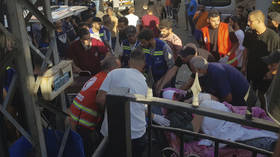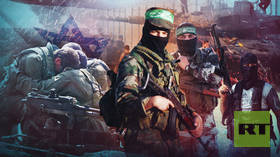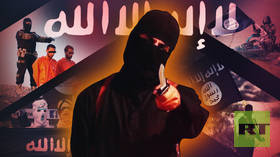Following a deadly cyber attack on the Shiite group’s communications, Lebanese authorities are blaming Israel, which is already preparing for a potential threat from the north
Eight people have died and 2,750 others were injured in the mass detonation of pagers in Lebanon on Tuesday, according to Lebanese Health Minister Firas Abyad. Hospitals in Beirut and other cities are overwhelmed, and the Ministry of Health has called on all available medical personnel to respond to the emergency.
Among the injured is Iran’s ambassador to Lebanon, Mojtaba Amani, as well as members of the Shiite group Hezbollah. A spokesperson for the organization, speaking anonymously to Reuters, described the incident as “the largest security breach” the group has faced since the conflict in Gaza began almost a year ago.

According to a source familiar with the situation who spoke to The Wall Street Journal, the exploding pagers were from a new batch that Hezbollah received recently. A representative of the group revealed that hundreds of fighters possess such devices. He suggested that malware may have caused the overheating and explosions. Some members reported feeling the pagers getting hot and disposed of them before they detonated.
It remains unclear what triggered this series of explosions, but Lebanese authorities believe Israel is behind a cyberattack. The Lebanese foreign ministry characterized the blasts as a “dangerous and deliberate Israeli escalation,” claiming they were “accompanied by Israeli threats to expand the war towards Lebanon on a large scale.”
In response, Israel has raised its alert level at all ports. “Israeli security officials believe Hezbollah plans military action, prompting an urgent meeting of senior officers at the defense ministry to explore options for a possible northern escalation,” noted the Israeli publication Haaretz.
But is Western Jerusalem prepared for such a conflict?
A long-standing threat
In 2006, Hezbollah, an Iran-linked militia in Lebanon, kidnapped two Israeli soldiers and killed eight others, prompting the IDF to respond and triggering what is now known as Second Lebanon War.
Back then, addressing the Knesset, then Prime Minister Ehud Olmert explained that Israel needed to go to war to protect itself from the ongoing rocket attacks of Hezbollah. He vowed to eliminate the group’s militants and destroy their infrastructure.
In 34 days of fighting, Israel’s airforce flew some 12,000 combat missions over Lebanon, leaving behind a tail of destruction. Large parts of Lebanese infrastructure were destroyed in the conflict. These included bridges, roads, water and sewage treatment plants, ports, schools, hospitals, private homes, and even Beirut International Airport.
Hezbollah was dealt a blow too. Out of that war’s 1,200 casualties, at least 270 were Hezbollah combatants. The group’s ammunition stores were damaged, and its launching grounds and military facilities were partially or totally destroyed. Israel presented it as a victory but Sarit Zehavi, the founder and president of Alma, an independent research and education center specializing in Israel’s security challenges, says victory was nowhere near.

“From 2006, we failed to defeat Hezbollah and it actually continued to launch rockets until the last day of the war… there was a lot of destruction in Lebanon, but the feeling was that we should have continued.”
But Israel didn’t. On August 14, a United Nations-brokered ceasefire came into effect. Less than a month later, Israel lifted its naval blockade of Lebanon and, two years after the eruption of the conflict, the bodies of the two Israeli soldiers were returned to Israel and laid to rest. Yet, the chapter of animosity between Israel and Hezbollah didn’t end with their burial. Hezbollah continued to arm itself, preparing for yet another confrontation.
The capabilities of the warring parties
As of today, and according to estimates, the Shiite militia possesses more than 200,000 rockets and missiles, 5,000 of which are long-range, able to hit areas up to 700km from their launch site. 5,000 are middle-range rockets able to fly up to 200km, 65,000 are short-range rockets with a range of up to 80km, whereas 150,000 are mortars.
In addition, Hezbollah also boasts hundreds of anti-tank, anti-ship and anti-aircraft missiles, plus 2,500 drones, a sophisticated system of tunnels, far deeper than those used by Hamas in Gaza, and most importantly some 50,000 combatants in regular services and 50,000 reservists – both groups well trained and well equipped.
Zehavi says Hezbollah was able to reach this might simply because Israel was looking the other way.
“For 18 years, nobody [in Israel] was monitoring [the situation]. Meanwhile, Iran was very much involved in this. [This way, Hezbollah was able to] smuggle munitions from Tehran to Syria, or they manufactured [weapons] in Syria and then brought them to Lebanon, so I am not at all surprised that the [military might of the group] grew so significantly.”
Over the years, Israel did try to harm Hezbollah’s ability to arm itself. Various reports suggested Israel was behind the attacks on convoys transporting ammunition in Syria, airports, research centers, and bases. But Eyal Zisser, a vice rector of Tel Aviv University and one of the most renowned Middle East experts, says these assaults have been largely symbolic.

“Hezbollah doesn’t really have forces, units and capabilities in Syria. It uses Syria as a land to transfer weapons from Iran to Lebanon. In the past, Hezbollah hoped to use Syrian territory against Israel, but most, 99% of its forces are in Lebanon. So the attacks of Israel in Syria are not as critical and not as important; they clearly don’t have a significant impact.”
In the current confrontation that kicked off on October 7, 2023 following the deadly Hamas attack on Israel and the subsequent Israeli incursion into Gaza, Israel attacked thousands of Hezbollah targets. In the first six months, more than 1,400 have been targeted from the air, 3,300 have been attacked from the ground. Hundreds of Hezbollah operatives have been killed, including 50 top commanders.
Zehavi says their elimination was significant given the fact that they possessed knowledge, connections and experience, but that didn’t harm Hezbollah’s capabilities to keep on fighting.
And now, with the drums of war sounding louder in the region, both experts agree that a confrontation with Hezbollah will be different to those experienced by Israel before.
“First of all, the terrain will be different,” said Zehavi. “It’s much more challenging than Gaza, it has hills and valleys. It’s more difficult to maneuver. It will be easier for Hezbollah operatives to hide there. [Secondly], the underground infrastructure of Hezbollah is much bigger, and [thirdly] munition is hidden in towns and villages but given that Lebanon is bigger, it would be possible for the population to leave areas of a war zone [to protect themselves],” she added.
Another challenge lies in the barrages of rockets that Hezbollah would be launching towards Israel. According to some estimates, on the first day of Hamas’ attack on Israel, the group fired 4,300 rockets. With Hezbollah, however, the daily numbers of rockets, missiles and drones promise to exceed 10,000, and the question is whether Israel will be prepared to handle it.
Apart from the Iron Dome missile interception system that proved efficient throughout Israel’s wars, the country has also developed other means aimed at protecting the country. David Sling is one of those technologies, another one – using a laser – will start to be operational soon, and the IDF is now working on a number of creative projects that would stop the infiltration of enemy drones.
“[During the attack of October 7], Israel was able to deal with the missiles of Hamas and no threat was posed to Tel Aviv, for example,” said Zisser.
“With Hezbollah, it will be entirely different. Israel has air-defense systems that are quite capable, but to deal with thousands of rockets… I really don’t know. This is something that we will have to wait and see whether Israel can really handle such a threat or it will be in a situation where it suffers casualties and hits by these missiles,” he added.

Zehavi agrees that one “can never be prepared enough for the war.”
“We don’t have enough shelters up north. [Plus] we only have 15 seconds to get to the shelter. So, we will see damages on both sides if a full-fledged war erupts.”
For now, Zisser is certain that a wide war is not on the table. “Neither of the sides is interested in this,” he asserted. The Americans are not willing to see this conflict either, and the chances are that Israel and Hezbollah will continue their war of attrition along the border. But, for Zehavi, the most important thing is, whether a full-fledged war happens or not, that the threat of Hezbollah is handled properly.
“The capabilities of Hezbollah need to be dealt with. The people of Israel want to live in peace, and the people of Israel are not going anywhere. So, we will stay here and we will continue to live here, and we will do whatever it takes to live in peace and to continue to live here,” she concluded.
